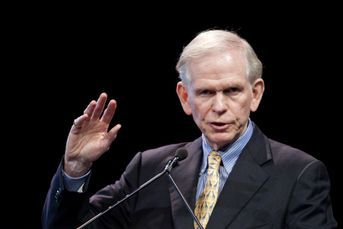How one manager invests like Buffett
Few follow Warren Buffett's maxim — “Put all of your eggs in one basket and then watch that basket” &mdash as diligently as Scott Moore. A high concentration of stocks should make investing more volatile but since November 2008, he's beaten the market.
“Put all of your eggs in one basket and then watch that basket,” Warren Buffett says. In other words, if you want to beat the market, focus your efforts on a concentrated portfolio of stocks whose businesses have been analyzed as thoroughly as possible to screen out any chance of a blowup.
Few follow this maxim as diligently as Scott Moore. The founder of Nuance Investments in Kansas City normally holds 15 to 35 stocks. Such concentration should make investing more volatile, as individual stock blowups have a greater impact on returns. Yet since he began running private accounts in this style in November of 2008, four months before the stock market hit bottom, he’s delivered a cumulative 182.5% return to the S&P 500’s 114.9, with 10% less volatility.
(See also: Warren Buffett’s top stock picks)
In May of 2011 Mr. Moore launched a mutual fund — Nuance Concentrated Value (NCVLX) &mdash with an identical strategy. While the fund and his $500 million shop are relatively new, Mr. Moore co-managed the American Century Equity Income Fund from October 1996 through September 2008. Over that time, the fund had a 215% cumulative return; the S&P 500 gained 107%. The new fund has an expense ratio of 1.16% and an investment minimum of $5,000 at brokers such as TD Ameritrade and Scottrade. Bloomberg News spoke with Mr. Moore on the phone.
Bloomberg News How would you describe your investment strategy?
Mr. Moore: It is a classic value strategy similar to Warren Buffett’s except we don’t hold companies forever like him. We’re trying to identify businesses that are No 1 or No. 2 in market share in their industries. We do a thorough analysis to see if they have a sustainable competitive advantage.
We try to buy them when there’s a transitory problem causing their earnings power to be depressed below normal levels. We calculate what the stock should be worth when earnings recover to normalized levels and what the worst case scenario could be. If the potential reward far exceeds the downside risk, we buy.
Bloomberg News What’s an example of that process?
Mr. Moore: Our largest holding Xylem Inc. (XYL) is a water infrastructure and equipment company. They provide pumps, valves, meters &mdash everything to get water from its primary source to a treatment facility and back to homes and businesses. Across their lines of business they have leading sustainable positions. Yet the company is under-earning its potential because of the debt levels in U.S. and European municipalities. These municipalities don’t want to spend on water infrastructure until their balance sheets are healthier. But we think the long-term story of water infrastructure is quite compelling.
Bloomberg News What is the long-term story?
Mr. Moore: There’s a great need for improved water infrastructure in rapidly growing developing nations. Even in the U.S. our water infrastructure needs updating. While today’s annual earnings per share for Xylem is $1.60, we think normalized earnings per share when municipalities start spending again will be in the $2 to $2.20 range.
Given this analysis, we feel the company has a downside share price limit in the low $20s, which was around where we were buying it this summer. Meanwhile, it has an upside value of about $40 a share. That’s the sort of risk-reward ratio we look for.
Bloomberg News How do you keep a lid on volatility in such a concentrated fund?
Mr. Moore: We buy sustainably well-positioned businesses whose downside is able to be analyzed. If we see stocks where the downside risk can’t be analyzed, we don’t own them. Those situations would be companies that are losing market share perpetually or going through a major competitive transition. Also, highly leveraged companies create situations where the downside could be to zero. We have no interest in those.
Bloomberg News Even though your portfolio is concentrated, do you have to limit sector or individual stock exposure?
Mr. Moore: The fund can’t be more than 25% in one industry or more than 15% in one stock. The most we’ve ever been is 13% in one name.
Bloomberg News What kinds of stocks are you buying now? Is there a sector where you’re finding good values?
Mr. Moore: We’re seeing more one-stock situations, such as Sysco Corp. (SYY) It has the leading market share in the food distribution and services industry.
The company has been under-earning its potential largely due to an information technology software implementation with SAP that is costly in the short-term but that will be well worth it in the long run. It just agreed to purchase competitor US Foods for $3.5 billion. We like the deal and think it will be helpful to earnings. Today’s earnings per share are about $1.80, and we think that will go to $2.50 at a minimum when the company recovers. In the meantime we’re collecting a 3.1% dividend.
Bloomberg News You also own Goldcorp (GG). Mining stocks have been one of the few sectors hit hard this year. What’s the story there?
Mr. Moore: Goldcorp is a leading business franchise with transitorily depressed earnings and an inexpensive stock valuation.
For all commodity company stocks we try to find the leaders based on their cash cost to produce the commodity. If you look at the gold markets as a whole, you’ll find a cost of production in the $1,100 to $1,200 an ounce range. For Goldcorp, the cost is closer to $700. So clearly it is a low-cost leader. It’s also now trading at a discount to its tangible book value. Historically with gold miners, if you can buy the low-cost leader below book value, it’s proven to be an outstanding investment.
Bloomberg News One advantage of working at a big shop like American Century is that you have a team of analysts. Can you cover the same ground running a smaller enterprise with a couple of people?
Mr. Moore: We had seven or eight investment guys there and we have three here. We’ll have four eventually and I think that’s the right number. Since we plan to close our fund and separate accounts when assets reach $1 billion, it will be easier to manage with less people.
One reason I launched Nuance was that I really missed being an investment analyst. When you’re managing $13 billion and have seven or eight people working for you like I had at American Century, you end up being a meeting administrator. You end up listening to analysts a lot. I wanted to get back to what I like to do and what I do best &mdash studying businesses.
Bloomberg News Do you invest in your fund?
Mr. Moore: Every dollar of my equity holdings is in these products. Not necessarily in the mutual fund, but it’s in these products.
Bloomberg News And the fund and separate accounts are run identically, so it doesn’t matter too much.
Mr. Moore: Correct. I don’t want anyone to think that I like one over the other. So my money is equally spread between the two.
(Bloomberg News)
Learn more about reprints and licensing for this article.








